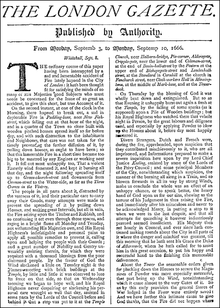The London Gazette
The London Gazette is one of the official journals of record or Government gazettes of the British government, and the most important among such official journals in the United Kingdom, in which certain statutory notices are required to be published. The London Gazette claims to be the oldest surviving English newspaper and the oldest continuously published newspaper in the UK, having been first published on 7 November 1665 as The Oxford Gazette.[note 1][2] This claim is also made by the Stamford Mercury (1712) and Berrow's Worcester Journal (1690), because The Gazette is not a conventional newspaper offering general news coverage. It does not have a large circulation.
 | |
 A London Gazette reprint of its front page from 3–10 September 1666, reporting on the Great Fire of London | |
| Format | Broadsheet |
|---|---|
| Founded | 7 November 1665 |
| Language | English |
| Headquarters | United Kingdom |
| Website | thegazette.co.uk |
Other official newspapers of the UK government are The Edinburgh Gazette and The Belfast Gazette, which, apart from reproducing certain materials of nationwide interest published in The London Gazette, also contain publications specific to Scotland and Northern Ireland, respectively.
In turn, The London Gazette carries not only notices of UK-wide interest, but also those relating specifically to entities or people in England and Wales. However, certain notices that are only of specific interest to Scotland or Northern Ireland are also required to be published in The London Gazette.
The London, Edinburgh and Belfast Gazettes are published by TSO (The Stationery Office) on behalf of Her Majesty's Stationery Office. They are subject to Crown copyright.
Current publication
The London Gazette is published each weekday, except for bank holidays. Notices for the following, among others, are published:
- Granting of royal assent to bills of the Parliament of the United Kingdom or of the Scottish Parliament
- The issuance of writs of election when a vacancy occurs in the House of Commons
- Appointments to certain public offices
- Commissions in the Armed Forces and subsequent promotion of officers
- Corporate and personal insolvency
- Granting of awards of honours and military medals
- Changes of names or of coats of arms
- Royal Proclamations and other Declarations
Her Majesty's Stationery Office has digitised all issues of the Gazette, and these are available online.[3]
The official Gazettes are published by The Stationery Office. The content, apart from insolvency notices, is available in a number of machine-readable formats, including XML (delivery by email/FTP) and XML/RDFa via Atom feed.[4]
History
.jpg)
The London Gazette was first published as The Oxford Gazette on 7 November 1665. Charles II and the Royal Court had moved to Oxford to escape the Great Plague of London, and courtiers were unwilling to touch London newspapers for fear of contagion. The Gazette was "Published by Authority" by Henry Muddiman, and its first publication is noted by Samuel Pepys in his diary. The King returned to London as the plague dissipated, and the Gazette moved too, with the first issue of The London Gazette (labelled No. 24) being published on 5 February 1666.[5] The Gazette was not a newspaper in the modern sense: it was sent by post to subscribers, not printed for sale to the general public.
Her Majesty's Stationery Office took over the publication of the Gazette in 1889. Publication of the Gazette was transferred to the private sector, under government supervision, in the 1990s, when HMSO was sold and renamed The Stationery Office.
"Gazetted"
In time of war, despatches from the various conflicts are published in The London Gazette. People referred to are said to have been mentioned in despatches. When members of the armed forces are promoted, and these promotions are published here, the person is said to have been "gazetted".
Being "gazetted" (or "in the gazette") sometimes also meant having official notice of one's bankruptcy published, as in the classic ten-line poem comparing the stolid tenant farmer of 1722 to the lavishly spending faux-genteel farmers of 1822:[6]
Notices of engagement and marriage were also formerly published in the Gazette.
Colonial gazettes
Gazettes, modelled on The London Gazette, were issued for most British colonial possessions.
See also
- History of British newspapers
- Iris Oifigiúil
- The Dublin Gazette – in Ireland
- London Gazette index
- Official Journal of the European Union
- List of government gazettes
Notes
- Until 1752 and the changes introduced by Calendar (New Style) Act 1750, the Gazette was published with a dateline based on the Julian calendar with the start of year as 25 March. Modern secondary sources usually adjust the start of the calendar year during this period to 1 January. Using this adjustment a London Gazette issue dated 4 January 1723 was published in 1724, the same year as an issue published on 4 April 1724 (See the article Old Style and New Style dates).[1]
References
- "No. 6231". The London Gazette. 4 January 1723. p. 1.; "No. 6257". The London Gazette. 4 April 1724. p. 1.
- "No. 1". The Oxford Gazette. 7 November 1665. p. 1.
- Search the London Gazette Archive
- "Data Re-use". The London Gazette. Retrieved 10 December 2015.
- "No. 24". The London Gazette. 5 February 1666. p. 1.
- By William Hone (1827); published by Hunt and Clarke.
External links
| Wikimedia Commons has media related to The London Gazette. |